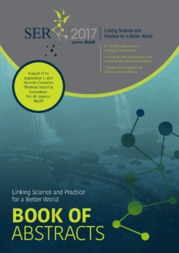Woody species and strategies for restoration in the Cerrado biome.
Woody species and strategies for restoration in the Cerrado biome.
Author(s): VIEIRA, D. L. M.; SAMPAIO, A. B.; SKORUPA, L. A.; ARCO-VERDE, M. F.; CAMPELLO, E. F. C.; MORAES, L. F. D. de; PERES, M. K.; ROCHA, F. S.; OGATA, R. S.; OLIVEIRA, M. C. de; DURIGAN, G.; ISERNHAGEN, I.; SOUZA, R. B. de; TURAZI, C. M. V.; RIBEIRO, J. F.
Summary: The success of native vegetation reclamation depends upon the knowledge about the species and planting strategies/models bestsuited for the area to be recovered. This work suggests more than 200 native species with their physiognomies of occurrence for theCerrado biome, associated to its ecological strategy of occupation (covering or diversity) and main categories of potential economicutilization for using in eight planting strategies/models. It aims to guide technicians and owners of rural areas on the choice of speciesand appropriate strategies for woody (forest and savannah) vegetation recovery of Cerrado biome. Strategies for restorationwith woody native vegetation vary from passive actions, as natural regeneration, to high intervention actions, such as those inAgroforestry Systems. Areas with greatest potential for natural regeneration have presence of regenerating seedlings, greater coverof native vegetation nearby and low presence of exotic and local competitors and it requires less labor and costs while areas withlow potential for natural regeneration demand intense intervention and more expensive technics. All restoration action has risksand must be monitored and managed according to the expected results. These actions will indicate if your strategy was adequateand well conducted. Actions should start in small areas to support new decisions if something fails. To attend the law of Protectionof Native Vegetation, these strategies can be applied in Brazil for Legal reserve (ARL) and Permanent Preservation (APP) areas.
Publication year: 2017
Types of publication: Abstract in annals or event proceedings
Unit: Embrapa Agrobiology
Keywords: Cerrado, woody plants
Observation
Some of Embrapa's publications are published as ePub files. To read them, use or download one of the following free software options to your computer or mobile device. Android: Google Play Books; IOS: iBooks; Windows and Linux: Calibre.
Access other publications
Access the Agricultural Research Database (BDPA) to consult Embrapa's full library collection and records.
Visit Embrapa Bookstore to purchase books and other publications sold by Embrapa.

